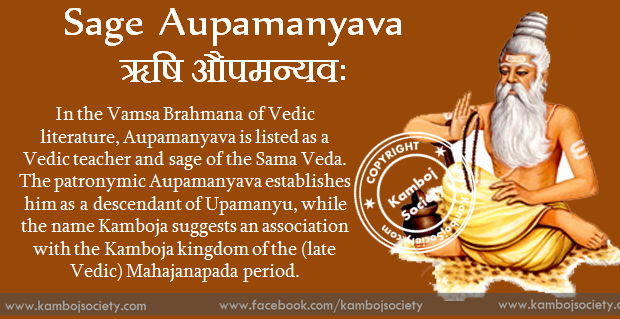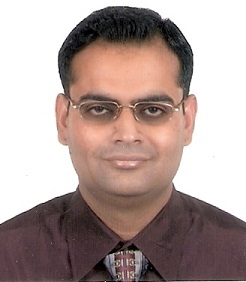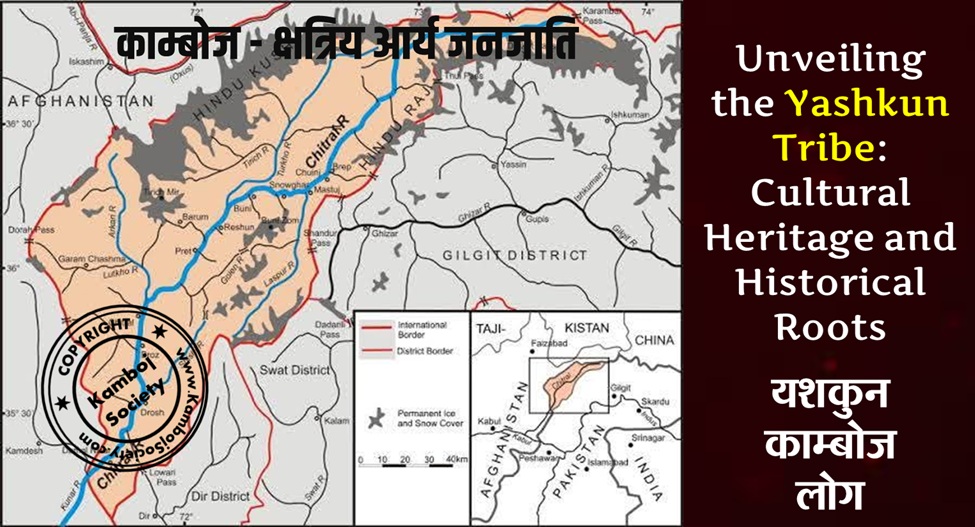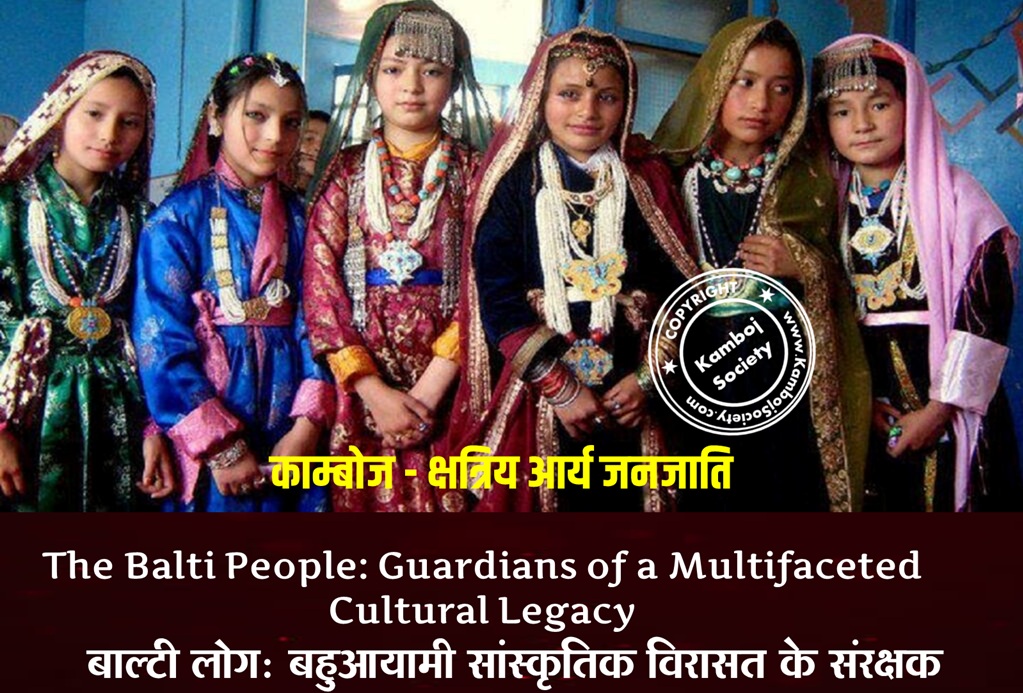In the Vamsa Brahmana of Vedic literature, Aupamanyava is listed as a Vedic teacher and sage.[1][2] of the Sama Veda. The patronymic Aupamanyava establishes him as a descendant of Upamanyu, while the name Kamboja suggests an association with the Kamboja kingdom of the (late Vedic) Mahajanapada period.[3][4] Vamsa Brahmana informs us that sage Anandaja had received the Vedic learning from sage Samba, the son of Sarkaraksa, as well as from Kamboja, the son or descendant of Upamanyu.
Lineage
Vamsa Brahamana[5] of the Sama Veda refers to one Rsi Madragara Shaungayani as the teacher of Aupamanyava Kamboja. As the name itself suggests, risi Madragara Shaungayani belonged to Madra tribe, i.e. the Uttaramadras. Dr Jain also observes: "Kamboja Aupamanyava, pupil of Madragara, is mentioned in the Vamsa Brahmana. This points to a possible relationship of the Madras or more probably of the Uttaramasdras with the Kambojas, who probably had Indian as well as Iranian affinities".[6]As a grammarian
Aupamanyava is repeatedly quoted as a grammarian by Yaska in his Nirukta, and also mentioned in respect of the Nisadas and the Panca-janah.[7][8][9][10][11][12] Aupamanyava is also stated to have authored one Nighantu–a collection of Vedic words [13] Pt Bhagva Datta points out that, Dr G. Opart has referred to one nirukta (etymology) whose authorship he attributes to a certain Upamanyu [14]Vamsa Brahmana
Commenting on the Vamsa Brahmana list of Vedic teachers, Albrecht Weber writes: "One fact deserves to be especially noticed here, namely, that several of the teachers mentioned in the Vamsa Brahmana, by their very names, points us directly to the north-west of India, e.g. Kamboja Aupamanyava, Madaragara Saungayani, Sati Aushtrakshi, Salamkayana and Kauhala" .[15] And commenting on the same list, R Morton Smith also writes: “The names Kamboja Aupamanyava, Sati Austraksi and Madragara Saungayani suggest a North-west connection for the main branch of Vamsa Brahmana.[16] It is interesting to note that among the entire lists of ancient Vedic teachers of the Satapatha Brahmana as well as the Vamsa Brahmana,[17] Kamboja Aupamanyava appears as the first "Aupamanyava"' (i.e. son or descendant of Upamanyu). This Kamboja Aupamanyava was the guru of Anadaja Chandhanayana who in turn was the guru of Bhanumant Aupamanyava.[18] Bhanumant Aupamanyava had instructed Urjayant Aupamanyava.[19] Vedic teachers Bhanumanta Aupamanyava and Urjayant Aupamanyava of the Vamsa Brahmana list were likely the son and grandson of Kamboja Aupamanyava.Aupamanyava/Upamanyu Gotra
Upamanyu also is one of the gotras of Hindu brahmins. The people with Upamanyu gotra live in far western part of Nepal and eastern Parts of Jammu & Kashmir. They are basically present just below the Mount Kailash as they pray to Lord Shiva only. However, according to Dr D. C. Sircar, Upamanyu gotra is not found in early Sanskrit literature and it is difficult to determine at this time whether it is a mistake for Aupamanyava gotra.[20] Prof B. N. Datta comments: "...In the list of Brahmana gotras mentioned in the Matsya-Purana,[21] the name "Kamboja" is to be found. It is said to be an offshoot of the Vrigu gotras. This means that a Rishi hailing from the Kamboja tribe was also founder of a Brahmanical class.......Weber says that the appearance of the name of Kamboja (an Indian sounding name in Vedic text) as a Sama theologian[22] is analogous of the discovery of the name of Gautama in Zoroastrian Mithra-Yesht.[23][24][25] Upamanyu was of Kamboja descent, and Ushtaxri (Sati Austrakshi) [26] was probably of Bactrian origin. Further, the name of prominent Rishi like Atharva sounds like Atharavan or Atharvan, the Persian fire-cult priest. The names of Atharva and Angirasa are connected with the introduction of fire-cult amongst the Vedic people. In this case, we find another infiltration of the foreign element (Kambojas etc.) in the ethnic composition of the Vedic Aryas" .[27]A traditional list (of words) has been handed down (to us). It is to be (here) explained. This same list is called Ni-gha??avas. From what (root) is (the word) Ni-gha??avas derived? They are words quoted from the Vedas (ni-gam??). Having been repeatedly gathered together from Vedic hymns, they have been handed down by tradition. Aupamanyava holds that, as these are the quoted words of the Vedas, they are called Ni-gha??avas on account of their being quoted (ni-gaman?t). Or else (the word Ni-gha??avas) may be (so called) from being fixed only (?han), i.e. (a list, in which) they (the words) are fixed together, or collected together (?h?). Now, what (are) the four classes of words? They are the following: noun and verb; prepositions and particles. With reference to this, they thus prescribe the definition of noun and verb: the verb has becoming as its fundamental notion, nouns have being as their fundamental notion. But where both are dominated by becoming, a becoming arising from a former to a later state is denoted by a verb, as ‘he goes', ‘he cooks', &c. The embodiment of the whole process from the beginning to the end, which has assumed the character ofbeing, is denoted by a noun, as ‘going', ‘cooking', &c. The demonstrative pronoun is a reference to beings, as ‘cow', ‘horse', ‘man', ‘elephant', &c.; ‘to be', to becoming, as ‘he sits', ‘he sleeps', ‘he goes', ‘he stands', &c. (Translation by Sri Lakshman Sarup - “The Nigha??u and The Nirukta”) Source: https://andhrabharati.com/dictionary/sanskrit/index.php
External links
- The Vam abrahmana: (Friedrich Max M ller, 1860): https://books.google.com/books?id=U-1jAAAAMAAJ&pg=PA443&dq=Bhanumat+Aupamanyava
- The Vam abrahmana: (TITUS version by Jost Gippert)
- The Vam abrahmana: ( Arthur Coke Burnell,1873): https://books.google.com/books?id=JtsoAAAAYAAJ&pg=PA5&dq=Bhanumata++Aupamanyava
References
- 1.18 ?nandaja?c?nd?an?yana? ??mb?cc??rkar?k?y?t K?mboj?ccopamanyav?t|| 1.19 ??mba? ??rkar?k?ya? K?mboja?caupamanyavo Madrak?r?cc?au?g?yane?|| 1.20 Madrak?ra? ?au?g?yani? sv?terau??r?k?e?|| – (Vamsa Brahmana 1.18-19).
- Vedic Index of Names and Subjects, 1958, p 149, Arthur Anthony Macdonell, Arthur Berriedale Keith - Vedas.
- Some Ksatriya Tribes of Ancient India, 1924, p 230, Dr Bimala Churn Law; See also: Altindisches Leben: Die Cultur der vedischen Arier nach den Sam?it?, 1879, p 102, Dr Heinrich Zimmer; Dialectics of Hindu Ritualism, 1956, pp 59, 133, Bhupendran?tha Datta; Pr?c?na Kamboja, jana aura janapada (Ancient Kamboja, people and country), 1981, Dr Jiy?l?la K?mboja, Dr Satyavrat ??str?; Literary History of Ancient India in Relation to Its Racial and Linguistic Affiliations, 1952, 165, Chandra Chakraberty; Balocist?n: siy?s? kashmakash, muz?mir?t va ruj??n?t, 1989, Mun?r A?mad Marr?; Indological Studies, 1950, p 7; The History and Culture of the Indian People, 1977, p 264, Dr Ramesh Chandra Majumdar, Dr Asoke Kumar Majumdar, Dr Achut Dattatraya Pusalker; The Racial History of India, 1944, p 810, Chandra Chakraberty; These Kamboj People, 1979, p 27-28; Bhandarkar Oriental Series, 1939, p 1, Bhandarkar Oriental Research Institute; Kambojas Through the Ages, 2005, pp 25-26, S Kirpal Singh.
- See: Vamsa Brahmana verse 1.18-19
- Ethnology of Ancient Bh?rata, 1970, p 108, Dr Ram Chandra Jain.
- Ref: Cultural Sources from the Veda, 1977, p 35, Sadashiv Ambadas Dange.
- Dialectics of Hindu Ritualism, 1956, pp 59, 133, Bhupendran?tha Datta.
- Bh?rat?ya Vidy?: A Quarterly Research Organ of the Bhavan on All Subjects Connected with Indian Culture, 1967, p 56, Bharatiya Vidya Bhavan, Bharatiya Vidya Bhavan (Bombay)-India.
- Encyclopaedic Dictionary of Vedic Terms, 2000, p 316, Parmeshwaranand - Vedas.
- Kamboja People and the Country, 1981, pp 204-205, Dr J. L. Kamboj.
- Political History of Ancient India, 1996, p 134, fn 1, Dr H. C. Raychaudhury, Dr B. N. Mukerjee. NOTE: Dr H. C. Raychaudhury cites reference to Aupamanyava (Nirukta II.2) and identifies him with Kamboja Aupamanyava of the Vamsa Brahmana (Ibid).
- For references to Aupamanyava Kamboja in Yaska's Nirukta, see: Dialectics of Hindu Ritualism, 1956, pp 59, Bhupendran?tha Datta; Political History of Ancient India, 1996, p 134, Dr H. C. Raychaudhury, Dr B. N. Mukerjee; Also: Kamboja People and the Country, 1981, pp 204-205, Dr J. L. Kamboj; Cultural Sources From the Vedas, 1977, pp 34-35, Sadashiv Ambadas Dange; Cultural Heritage Of India, 1958, pp 292-293, Article contributed by Dr V. D. Aggarwala.
- Catalogue of Sanskrit Manuscripts, Part II, p 510, Dr G Opart.
- See: The history of Indian literature, 2001 (edition), pp 74/75, fn 71, Albrecht Weber; See also I St., IV, pp 378-80.
- Dates and Dynasties: Part III : the Brahmans, 2000, p 79, R Morton Smith - Brahmans.
- A History of Ancient Sanskrit Literature So Far as it Illustrates the Primitive Religion of the Brahmans, 1860, pp 438-444, Friedrich Max M ller - Sanskrit literature.
- Vamsa Brahmania 16-15.
- Vamsa Brahmana 15-14
- Epigraphia Indica, XXXIII, p 193.
- Matasya Ourana Ch. 195, Sl. 336.
- Vedic teacher Kamboja Aupamanyava mentioned in Vamsa Brahmana, 18.
- Hymn to Mithra.
- Windischmann, Mithra, pp 29, 79.
- Indische Studien, herausg, 1858, p 356, Albrecht Friedrich Weber; Monatsberichte der K niglichen preussische Akademie des Wissenschaften zu Berlin, 1858, p 5101, K niglich Preussische Akademie der Wissenschaften zu Berlin.
- According to Vamsa Brahmana of Sama-Veda, Sati Aushtrakshi was the teacher of Madaragara Saungayanai. Madragara Saungayani was the guru of Kamboja Aupamanyava who in turn was the guru of Anandaja Chandhanayana. It appears that sage Ushtaxri/Ushtakshri was one of the two gurus of Sati Aushtrakshi, the second being Susravasa Varshaganya (See Vamsa Brahamana verses 18-22)
- Dialectics of Hindu Ritualism, 1956, p 59, 60, 132, Bhupendran?tha Datta.










